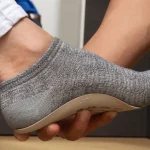Once only seen on the feet of the most elite-level athletes, racing shoes are becoming more visible deeper in the fields of many races. Claire Wood, footwear product line manager at Brooks says, “Ten years ago, only the front line would be wearing the racing flats. Now you see them in the middle of the pack. Over the years, the less-elite runner has become more comfortable with racing flats.”
Across brands, sales of racing flats are stable and steady. “Racing flats arent a huge growth category, but I think there has been a slight increase due to more and more runners who are becoming seasoned enough to realize that, For this 5k or 10k I want a lighter, faster shoe,” says Wood. “You see more of the average runner wearing them.”
According to Terry Schalow, product manager of performance running at ASICS America, high-end-racing shoes contribute to a brands overall performance image.
“We have three high-end racing flats targeted to different kinds of people and events,” says Schalow. “Certainly, if you have a high-end technical series of racing flats, you are going to create an image for your brand that I believe is really important for those athletes that are beneath the elite level, whether they are wearing racing flats or not. Its going to create an image for your brand that translates into sales of other products. There is definitely a halo effect.”
Wood agrees. “With performance running brands, the goal of Brooks and every one of our competitors is to have a shoe for every runner across a broad spectrum. Women, elite, competitive runners, and not-so-elite runners are buying racing flats. Anyone who cares about running will look at what the elites are wearing. There will always be a role for [flats]. Its an absolute necessity in the product line,” she says.
ASICS recently introduced a high-end, super-elite model called the Piranha SP that weighs a mere 4.7 ounces. “For those in the know,” says Schalow, “our Japanese parent company is famous for their super-lightweight, high-end racing flats that they provide to athletes around the world. They are very expensive to bring into the United States, but we managed to do that. With that particular model, we put our own upper on it that was more appropriate for the American market.”
Schalow adds, “Every brand, particularly New Balance and Adidas, have very lightweight racing flats that come in under 5 ounces. What makes ours different is that it actually has some midsole to it. Typically, a flat of this weight is paper-thin so your legs get pounded. Thats the trade-off for a lightweight flat.”
With two models on the market, Wood reports that Brooks has the highest market share of running flats in the specialty running channel.
Woods says, “Were always trying to keep the versatility element with the racing flats for runners who train with minimalist shoes; they are not necessarily just for racing. Were very proud of our racing flats. There arent a lot of bells and whistles and gimmicks. We believe it has to be a true performance product.” She adds, “Its not a huge part of our line in terms of market share, but we are very pleased in how we have delivered the product to market.”
As more women compete in distances from 5k to the marathon, more sales opportunities may follow. Schalow points out that in general, most racing flats are gender-neutral. “There are not many choices for womens-only racing flats. The reason for that is most racing flats work pretty well as a unisex shoe because by their nature, they are quite narrow and fit a womans foot well. Thats not me trying to make an excuse for not have womens racing flats. I wish there was a bigger retail [demand] for womens racing flats. We would certainly produce them if that was the case,” he says.
Outside of traditional road racing applications, racing shoe models that address competitive trail running are making inroads.
Lisa Mikkelsen, spokesperson for Inov-8, recalls, “In June of 2003, our founder, Wayne Edy, watched a mountain running race and noticed that the competitors were wearing mostly road racing flats. These are lightweight shoes, but they also didnt provide the grip that the runners needed off-road. Since then, weve seen that for off-road racing, lighter-weight shoes that offer lower profiles have been the trend. Inov-8 likes to believe we are helping to lead the way with this trend as our footwear designs are based on the philosophy of light weight, low profile and flexible shoes that allow your feet, and therefore your body, to work as they would naturally, if the feet were bare.”
Xterra footwear designers Ashley Brown and TJ Gray had a similar experience. At the Xterra World Championship in Maui last October, they noticed that many competitors were wearing road shoes. In the final leg of the race-a seven-mile trail run over roots, rocks and ravines-only one in 100 shoes worn was a trail runner. The athletes were sacrificing stability for lighter weight. Xterra introduced trail racing shoes at the August 2007 Outdoor Retailer Summer Market show.
Overall, racing remains an important component of a footwear brands product mix. Schalow says, “Demand continues to be steady and slightly growing. Sales of running shoes represent a much smaller percentage of the business than it used to, but keep in mind thats relative to the number of people who are participating in a sport that has grown astronomically.”















